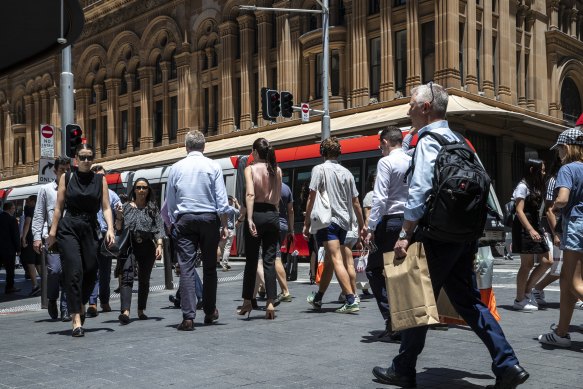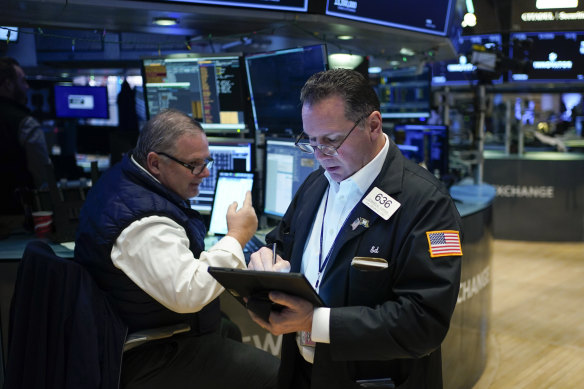ASX jumps as jobless rate rises to 3.7 per cent; AMP plummets
By Najma Sambul and Stan Choe
The Australian sharemarket extended its early gains on Thursday after a government report showed the nation’s unemployment rate unexpectedly rose to 3.7 per cent, sparking hopes it may prompt the Reserve Bank to go softer on rate rises.
The S&P/ASX 200 climbed 66.7 points, or 0.9 per cent, to 7418.90 as of 12.24pm am AEDT.
Market heavyweight Telstra rose, having increased its dividend after a strong half-year result. AMP plummeted after the embattled money manager said underlying earnings fell by a third as clients continued to pull their money from its funds.

The bourse jumped higher in late morning trade after the Australian Bureau of Statistics revealed the number of unemployed people increased by 22,000 in January, lifting the unemployment rate to 3.7 per cent. Economists had expected the unemployment rate to hold steady at 3.5 per cent. The rise in the jobless rate is a sign the economy has begun to cool, triggering hopes the RBA could rethink the extent of further rate rises.
Treasurer Jim Chalmers said in a press briefing after the release that the lift in the unemployment rate was an expected consequence of the global economic troubles and rising interest rates.
“We have been expecting an uptick in the unemployment rate as the economy slows a bit, as the obvious consequence of a slowing global economy mixed with the impact of interest rate rises here in our own economy,” he said, adding that Treasury and the Reserve Bank expected the economy to slow further, and employment to continue to rise in coming months.
RBA governor Philip Lowe earlier this week denied accusations he and his board were trying to drive the country into recession, while warning interest rates are yet to peak as the bank fights to bring down inflation. The central bank last week lifted the official interest rate by 0.25 percentage points to 3.35 per cent and warned more rate rises were on the cards in coming months.
Telstra’s share price went up 1.9 per cent to a 12-month high of $4.21 after the nation’s biggest telco said net profit climbed 25 per cent to $900 million in the December half, thanks to growth in its mobile business and the acquisition of Digicel Pacific. The company raised its interim dividend to 8.5 cents a share, from 8 cents a year ago.
Strong gains from other IT and communication services also helped lift the local bourse. Carsales.com and Xero rose 3.2 per cent and 2.6 per cent, respectively.
Health company Sonic Healthcare’s shares jumped 9 per cent after the company revealed at its half-yearly earnings that its base business revenue outside COVID tests rose 6 per cent from the same time last year, while net profits were up by 50 per cent on where they were before the pandemic.
On the flip side, shares in financial services group AMP plunged 13.2 per cent to $1.14 after its full-year profits missed market expectations as the company seeks to narrow its focus to wealth management and banking. Underlying profits fell by about a third to $184 million, coming in well below market expectations. Assets under management slipped to $124.2 billion, from $142.3 billion, due to weaker investment markets and $5.3 billion in net cash outflows.
The finance sector overall was still in the red after concerns about Commonwealth Bank’s future margins roiled investors on Wednesday. CBA, the nation’s biggest bank, extended Wednesday’s losses by 0.4 per cent in early trade. However, National Australia Bank went up 1.3 per cent to $30.72 after saying its first-quarter profits jumped by close to a fifth to $2.05 billion, as revenue increased sharply thanks to higher interest rates and growth in its loan portfolio.
Top Australian gold miner Newcrest lost 1.5 per cent after its board rejected a takeover proposal from US mining giant Newmont, arguing it undervalues the company, but has agreed to open its books to extract a higher offer.
Coalminer Whitehaven’s share price tanked 8.4 per cent despite the company’s 432 per cent profit jump to $1.8 billion after half-yearly revenue peaked at $3.8 billion. Big miners Rio Tinto and BHP were slightly up on Thursday morning’s trade.

The ASX had opened slightly higher this morning after gains on Wall Street overnight following a stronger-than-expected US retail sales report sparked optimism about the resilience of the world’s largest economy.
The S&P 500 rose 0.3 per cent overnight after swinging from early losses to gains through the session. The Dow Jones Industrial Average edged up 0.1 per cent, while the Nasdaq composite rose a more forceful 0.9 per cent.
Sales at US retailers jumped by more last month than expected, even as shoppers contended with higher interest rates on credit cards and other loans. The surprising strength offers hope that the most important part of the US economy, consumer spending, can stay afloat despite worries about a possible recession looming.
At the same time, though, the strong spending potentially adds more fuel to inflation, which a report earlier this week showed is taking longer to cool than expected. Upward pressure on inflation could force the US Federal Reserve to stay more aggressive in keeping rates high.
High rates can drive down inflation, but they also drag on investment prices and raise the risk of a painful recession.
“Will it lead to that traditional recession or a shallow recession, or will we power through it and have more strong growth with still-high rates?” asked Tom Hainlin, national investment strategist at US Bank Wealth Management. “That’s still the unknown, which is how resilient can the consumer be in this higher for longer” rate environment.
“It seems like both consumers and corporate America came into this in pretty good shape and so far are holding out OK,” he said.
The next big milestone for markets will likely be the Fed’s meeting in late March, when policy makers will give their latest forecasts for where interest rates will be at the end of the year, Hainlin said. That could lead to choppy trading in markets until then.
On Wall Street, shares of Airbnb jumped 13.4 per cent on Wednesday after reporting stronger profit and revenue for its latest quarter than analysts expected. It also said trends remained encouraging into the new year, and it gave a forecast for revenue that topped Wall Street’s.
On the losing end were stocks of energy producers, which fell 1.8 per cent for the worst performance by far of the 11 sectors that make up the S&P 500.
One of the sharpest drops came from Devon Energy, which fell 10.5 per cent after reporting weaker profit for the latest quarter than expected.
with AP
The Market Recap newsletter is a wrap of the day’s trading. Get it each weekday afternoon.
Most Viewed in Business
Source: Thanks smh.com